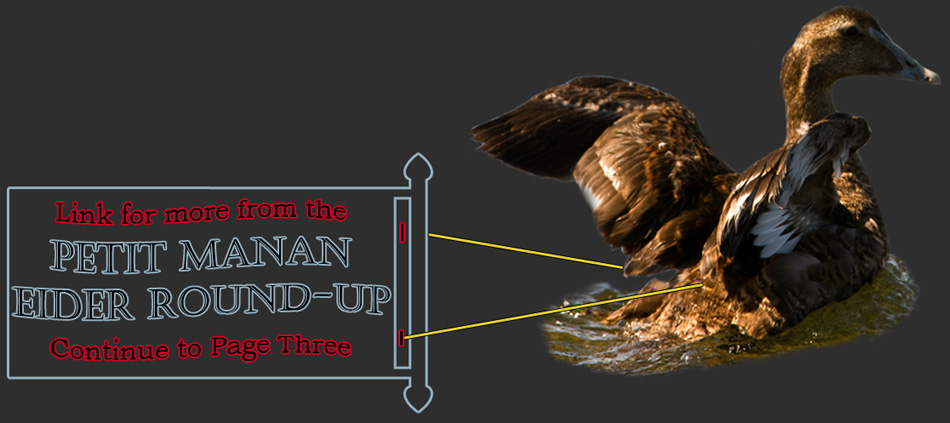
|

|
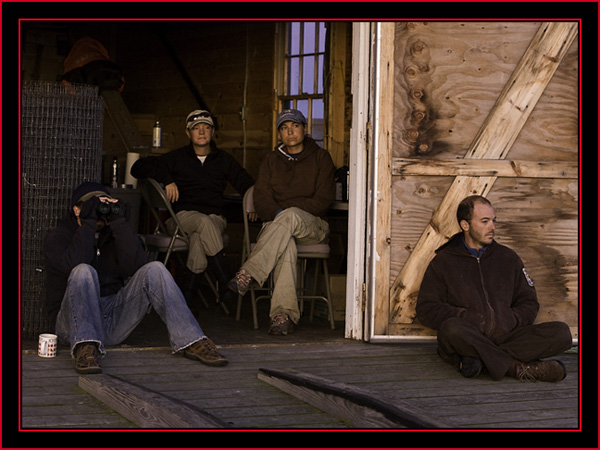
|
Returning to the boathouse I was greeted with the scene at left… The sun wasn’t above the horizon yet and this group was seeking birds and prepared for banding captures. In view from the left are Rob Lambert, MDIFW,
Pam Loring and Alison Kocek, both Fall Songbird Migration Technicians who had been banding songbirds on the island for about a month, with a month remaining with USFWS and Steve Agius, also of the US Fish &
Wildlife Service. I thought this effort was exceptional and it was the first time I’d been present for banding of smaller species.
Both mornings I was on the island found me near their work station as they went about the examination, banding and documentation process on the birds they netted. I have observed and photographed a plethora of birds through my lenses for my Bird Photography Index as a proletarian, but this entire trip was about real avian science which I found interesting indeed. The ladies may not have appreciated my being around especially but after a time I think they came to believe I was serving some kind of purpose and I even got them to pose with their captures occasionally.
The Early Crew - Rob, Pam, Alison & Steve...Canon EOS Mark III 1Ds, 1/125 second at 75mm; EF70~200mm f/2.8L at f/4, ISO 3200 |
Sunrise Views from Petit Manan Island

|
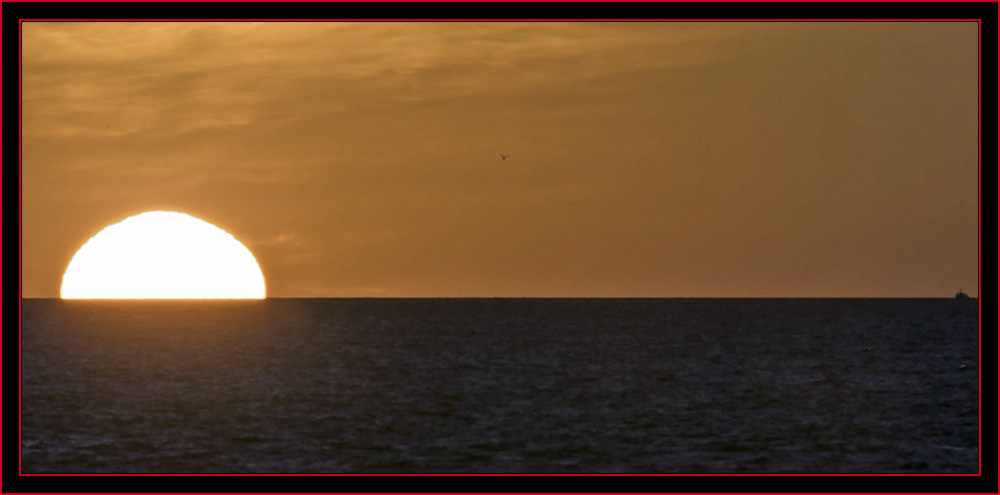
|
There were a series of ‘capture zones’ set up and this activity appeared to take place in the pre-dawn through late morning. Mao later informed me the nets used for these captures are referred to as 'mist' nets
and this capture process referenced as 'mist netting' – I can see why…
Pam and Alison stayed on the island full time during their tenure conducting this data gathering, so they may have kept the nets up all day
generally unless the wind was up to the point it posed a danger to the birds. There was a great deal of activity on the island now with the eider round-up plan so they were on a morning schedule. I was intrigued with their efforts as they worked with these delicate and
exquisite songbirds. Seeing these creatures up close was amazing, it’s difficult to appreciate their actual size when viewed through a lens or other optics.
Working the Mist NetsCanon EOS 5d, 1/1000 second at 200mm; EF70~200mm f/2.8L at f/5.6, ISO 640 |

|
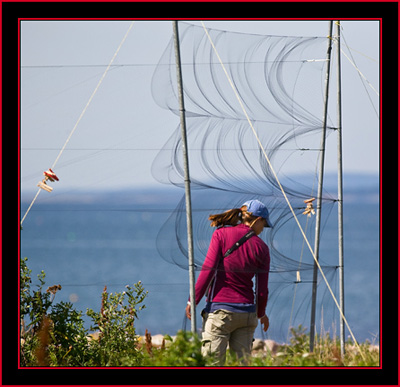
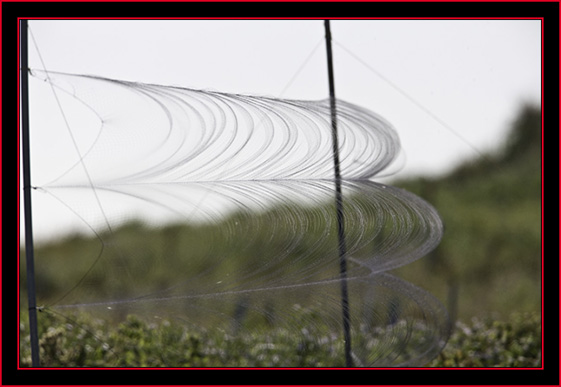
|
Magnolia Warbler Views

|


|

|
The birds were carefully inspected for parasites and overall condition, weighed, banded, measured, documented and released. None of this took long and they worked quickly to minimize stress to the subjects. I was interested
in this process and by asking questions, having the ladies turn towards the camera to capture an image or whatever slowed down the process a bit – I’m certain they thought this was just great... Pam & Alison had a work
station set up just inside the boathouse doorway and by now the sunlight was pouring into the space creating an issue to capture the scene. They weighed the birds by placing them in a small tube that appeared to be something like a
one inch by four inch section of PVC. Seeing a tiny songbird projecting out of this tube was a sight to behold…
Pam Documenting a CaptureCanon EOS 5d, 1/500 second at 200mm; EF70~200mm f/2.8L at f/4, ISO 640 |
I’d learned that I actually did know somebody previous to meeting the folks on the island… Yesterday when Robby Lambert arrived I didn’t realize this until he walked by my primary tripod system. He looked this over and stated, ‘Hey,
I’ve seen this rig before’ – I turned to look at him and yes, I too recognized Rob from various bird walks and field time around the Portland area. We talked for a bit and he indicated he’d moved north around Bangor and had
been working with Kelsey Sullivan at Maine Fish and Wildlife. Rob is a biologist specializing in birds and although I didn’t know him well personally, knew he was an expert birder by reputation and seeing him in action – a true font of avian
knowledge. I hadn’t known this was his field of endeavor professionally but this information came as little surprise. The group I was privileged to be spending time with on Petit Manan were the ‘real deal’…
Robby Lambert Inspecting a WarblerCanon EOS 5d, 1/500 second at 200mm; EF70~200mm f/2.8L at f/4.5, ISO 640 |

|
Northern Flicker Views
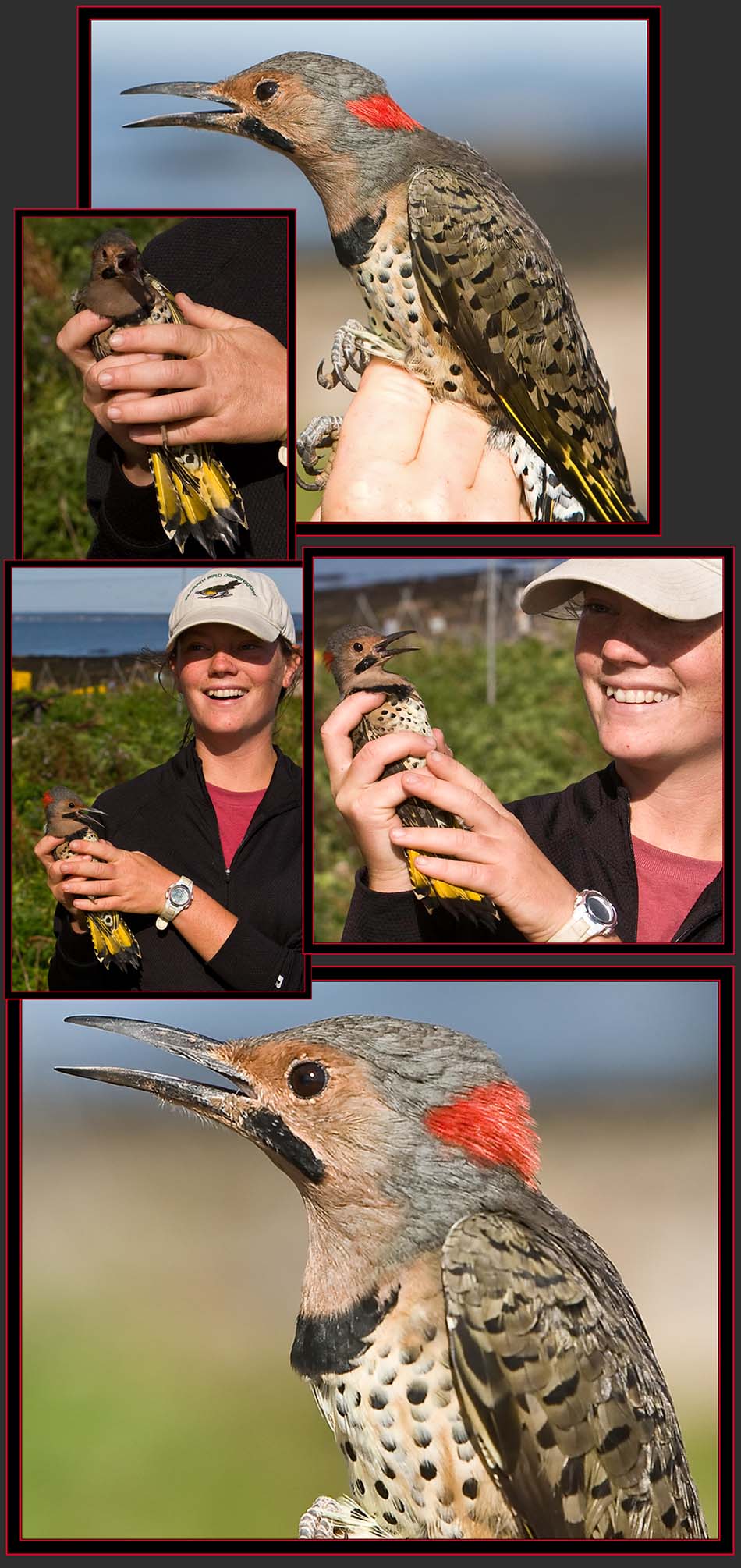
|

|
My primary camera system as viewed at left - Canon EOS 1Ds Mark III camera, Promaster Flash Extension Cord going from the camera to the off-shoe 580EX flash and Better Beamer Flash Extender; EF 600mm f/4L Imaged Stabilized lens
with a EF 1.4X extender = 840 millimeter focal length; the lens is mounted to a
Wimberley Head Version II gimbal on a Gitzo GT5530s heavy-duty tripod rated for fifty-five pounds. Collectively the system weighs around twenty-seven pounds and unless something prevents it like photography at sea or similar, I
never go into the field without it. Should anyone be interested in learning more about my equipment and lens choices I refer you to my web article: My Canon Photographic System.
And it wasn’t just captured birds for photographic opportunities this morning. There were many subjects in the area in the air and moving about on the island. Besides songbirds we observed an active pair of Peregrine Falcons hunting between Petit Manan and Green Islands, a pair of adult Bald Eagles, a juvenile Bald Eagle, at least one Northern Harrier, a plethora of gulls in various species and when the tide changed, many shorebirds coming into forage. I positioned my tripod to photograph some of the flybys in between the many other activities underway and later spent a good bit of time imaging the shorebirds. Photographic System on Petit Manan Island |
Peregrine Falcon Flyby Sequence
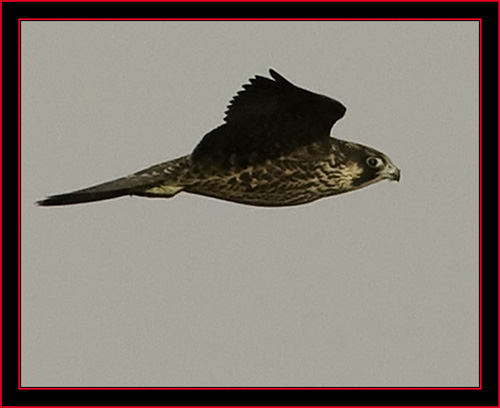
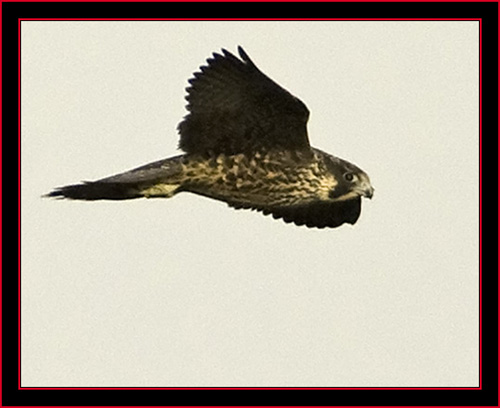
|
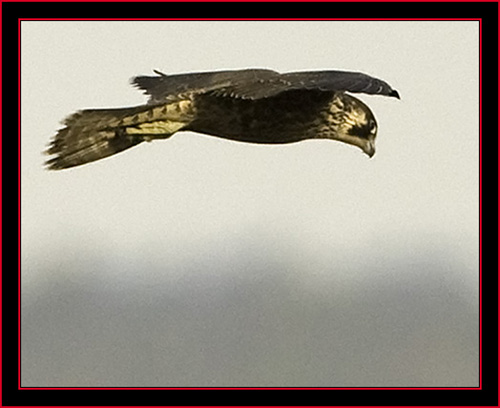
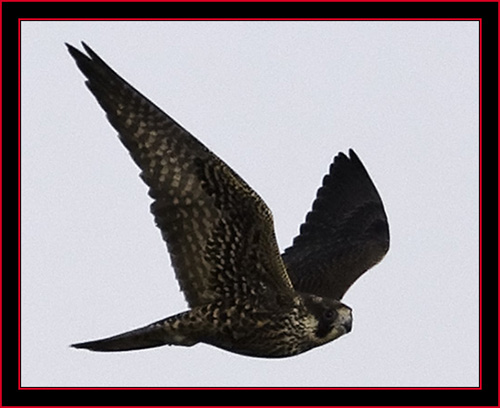
|
Laughing Gull and Common Loon Flyby
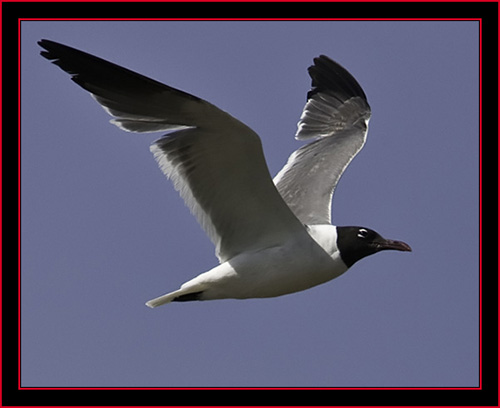
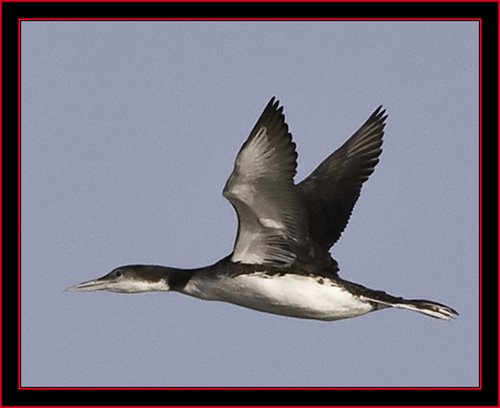
|
Long Distance Views of a Bald Eagle on Green Island
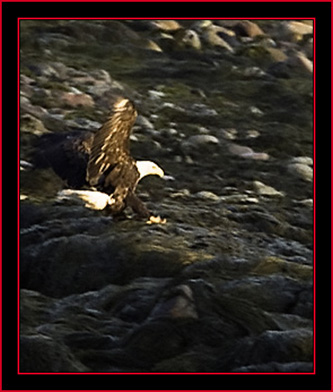
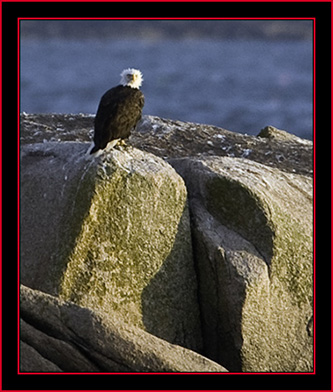
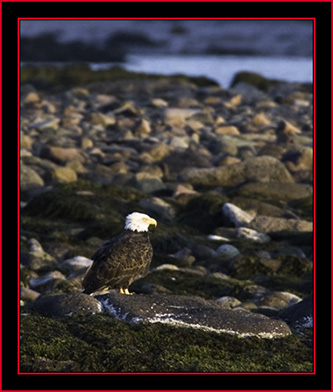
|
Laughing Gull Chasing a Juvenile Eagle & Great Black-backed Gull

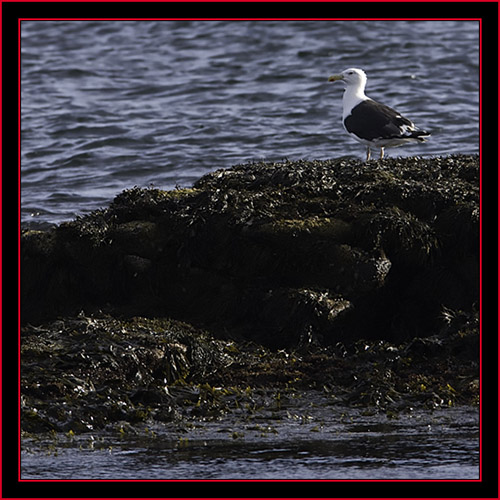
|
The sun had been up for less than a few hours and there was activity and photographic opportunities all around. The entire crew was out and constructing the barrier to channel the eiders by now and I knew
I’d have to shift my efforts to capture everything going on. It was a busy and wonderful morning… To provide some idea of the activity level this is what I observed as I looked around – a crew painting the
boathouse, the bulk of the staff was moving materials near the capture zone and constructing the barrier for the round-up as the tide changed, some were on the water reconnoitering to learn where the eiders
were presently in anticipation of moving the flock, a few were preparing the kayaks and inflatable boats that would be used in this effort and of course the fall migration banding effort continued all the
while. None of this is difficult to verify due to my photographic record archived from the time. I photographed, well – everything… Linda put me on the island to take pictures and I did this nearly non-stop. If
you’re reviewing this article you can be assured the images posted in this account are only a sampling of the exposures from my time on the island.
Juvenile Cedar WaxwingCanon EOS 5d, 1/500 second at 200mm; EF70~200mm f/2.8L at f/4.5, ISO 640 |

|
Cedar Waxwing & Savannah Sparrow

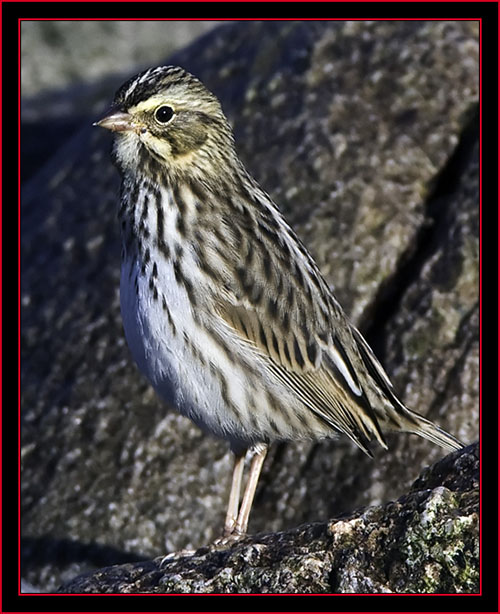
|
Juvenile Bald Eagle & Northern Flicker
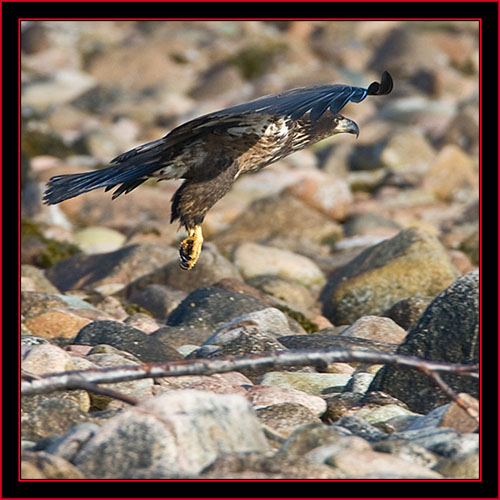
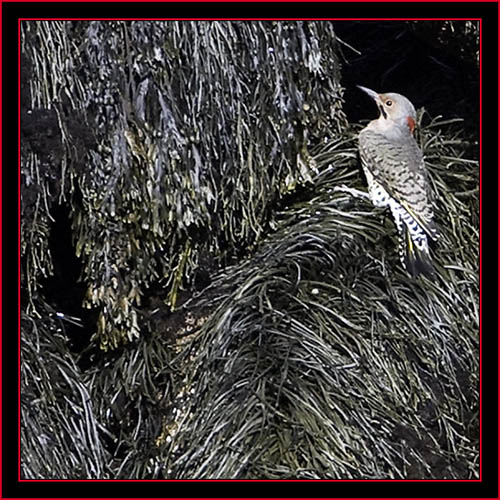
|
The Eagle Files
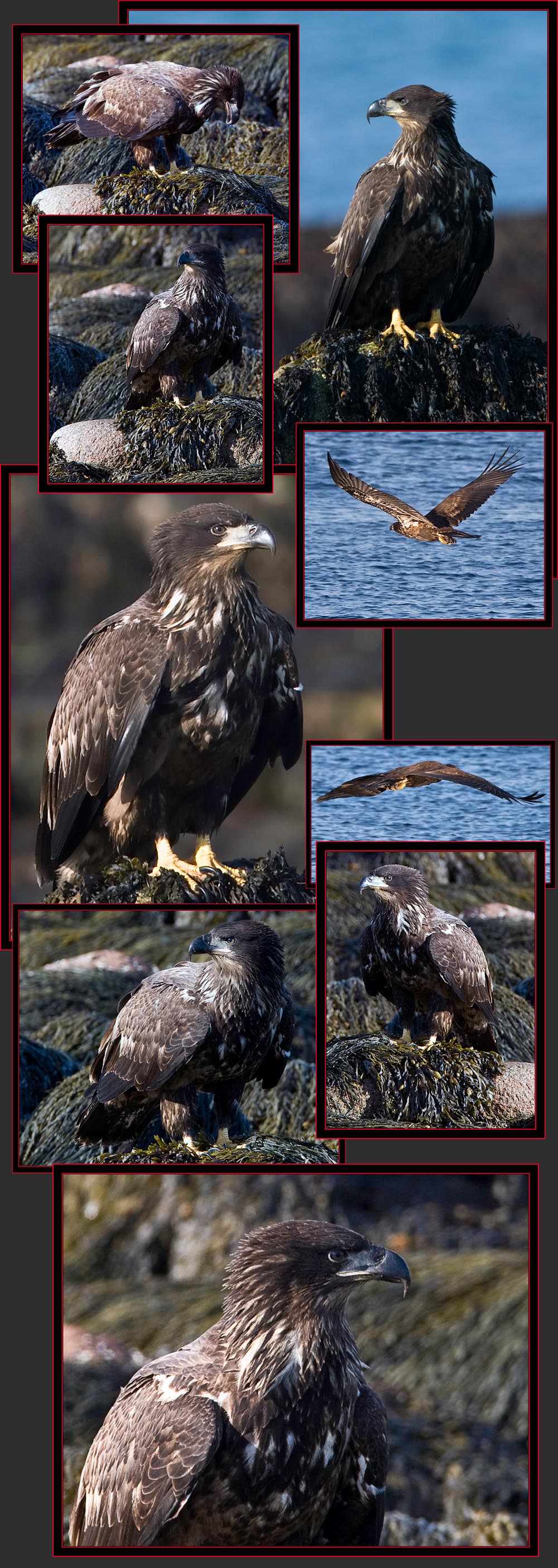
|
Blackpoll Warbler Views
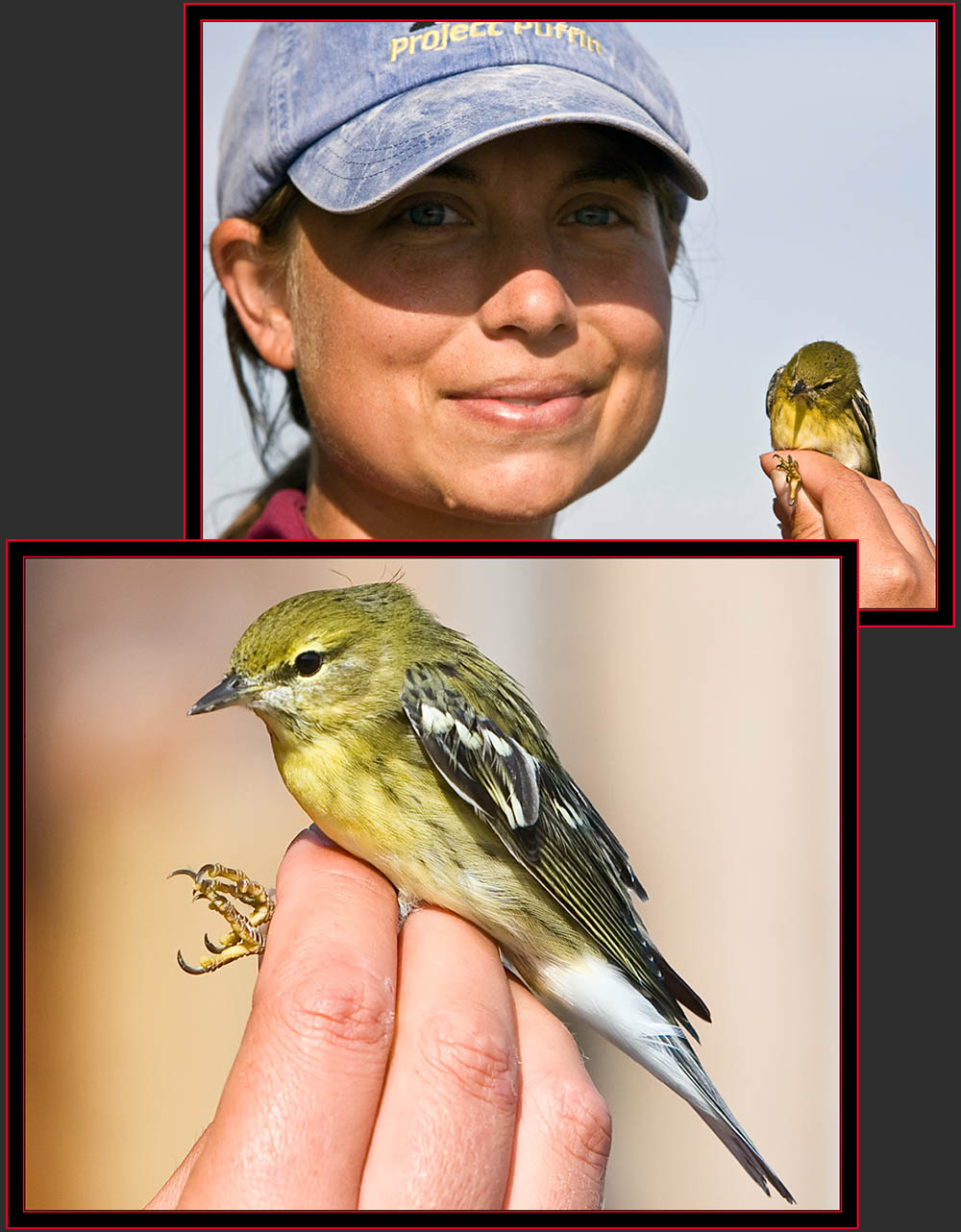
|
Documenting a Savannah Sparrow Capture
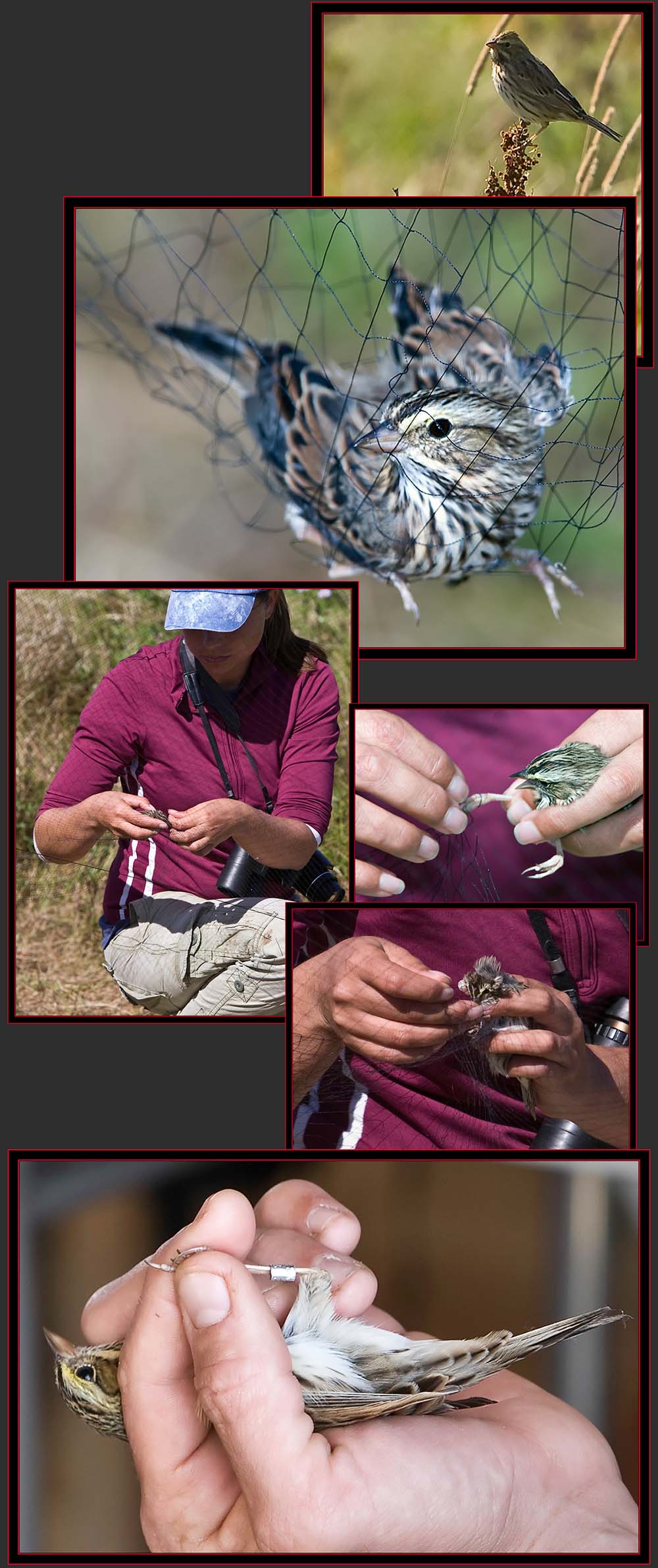
|
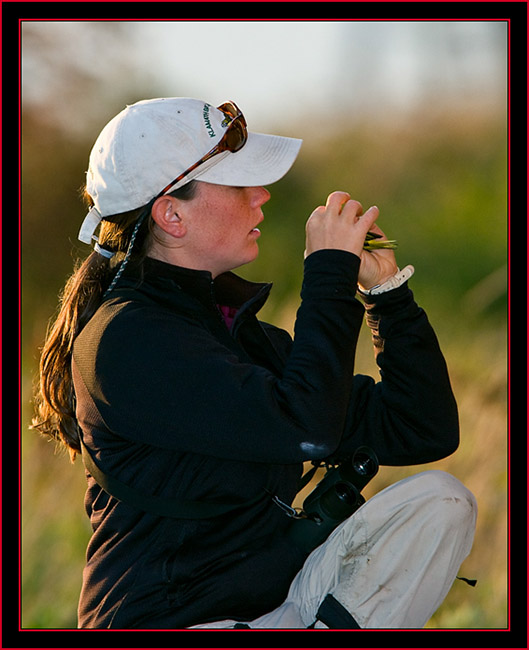
|
I spent a good bit of the morning photographing captures for the fall songbird migration banding effort. I didn’t observe all the captures in between photographing other activities but did have a fair sampling. I’d asked Pam and Alison to hold on to any banded birds briefly until I could get a few
photographs for record – I was never far away, but they wouldn’t do anything to prolong holding subjects and in the end result I did miss a few. One species I was a bit disappointed about missing was a Lincoln Sparrow Alison indicated they’d netted. I’m
going to add one more species below before moving on with the account…
At left is one my favorite images from the morning... I believe this photograph is indicative in exhibiting the dedication and conscientious approach these young biologists convey to their efforts. Pam Inspecting a CaptureCanon EOS Mark III 1Ds, 1/200 second at 840mm; EF600mm f/4L + 1.4X at f/8, ISO 800 |
Common Yellowthroat Views
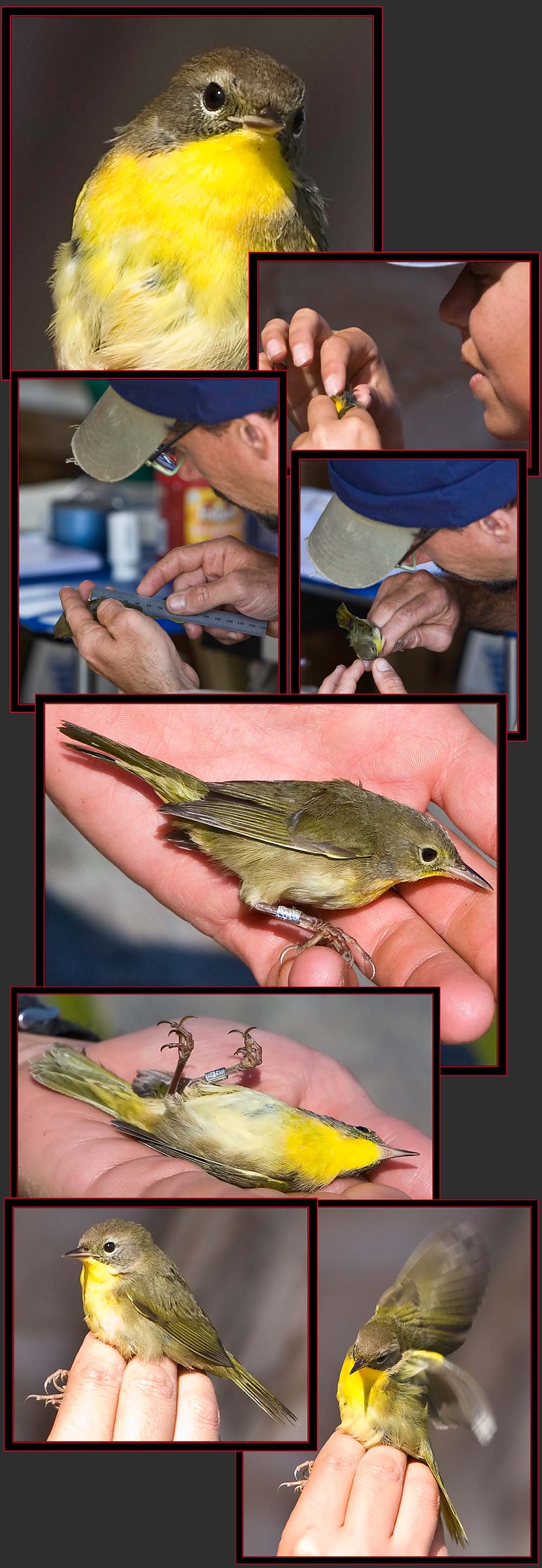
|
|
Jim and crew were doing excellent work and the boathouse painting was really making the building shine. It looked considerably improved in the short time I’d been on the island. And it wasn’t just the boathouse… They were painting several of the buildings around the lighthouse as
well. Jim and Craig would help with the round-up preparations and as soon as whatever task was completed they’d be right back on painting and pre-winter measures. This was true of many of the staff – nobody wasted any time, always stayed busy, and
Jim kept everybody organized and working to a plan.
It was approaching time for the incoming tide and the main event – the Eider round-up… For the purposes of this account where much of the activity was happening concurrently, I decided to add one more section below before concentrating on the primary purpose of my visit. With the incoming tide came the shorebirds… Craig & Jim Painting the BoathouseCanon EOS 5d, 1/1600 second at 200mm; EF70~200mm f/2.8L at f/8, ISO 640 |

|

|
I had a good idea where I wished to locate to photograph shorebirds after viewing the activity yesterday. I have many shorebird images in my archives and will most likely have many more before my photographic efforts cease. If asked to produce the single
best image of a particular species it would prove problematic as I’d have so many files to check from multiple locations to make the selection. I’ll photograph these birds at every opportunity and I enjoy getting among them when I can. Today on the
island, even with the level of activity going on around me to photograph, was definitely one such opportunity…
Sanderling on Petit Manan IslandCanon EOS 5d, 1/4000 second at 400mm; EF400mm f/5.6L at f/5.6, ISO 640 |
I’ve found the key to getting close to shorebirds is to stay low and become part of their environment. I’m not averse to crawling around when I need to but this isn’t desirable in a rock strewn area as I was in today or when shooting from a mud flat for
example. Getting down and dirty yourself is one thing but keeping the camera equipment clean, in particular the optics, and serviceable is a real consideration. Besides, I haven’t found a suitable method to crawl about with a 600mm lens on a tripod, which
would relegate one to a handheld system. I didn’t pack much I wasn’t absolutely certain I’d need this trip but I did transport the folding stool I always carry with my camera gear just for this purpose. I selected a spot that would provide close to a dry
hour as the tide rose, lowered my tripod legs to the correct height to operate the camera while seated and got comfortable…
Semipalmated Sandpiper on Petit Manan IslandCanon EOS Mark III 1Ds, 1/640 second at 840mm; EF600mm f/4L + 1.4X at f/8, ISO 640 |
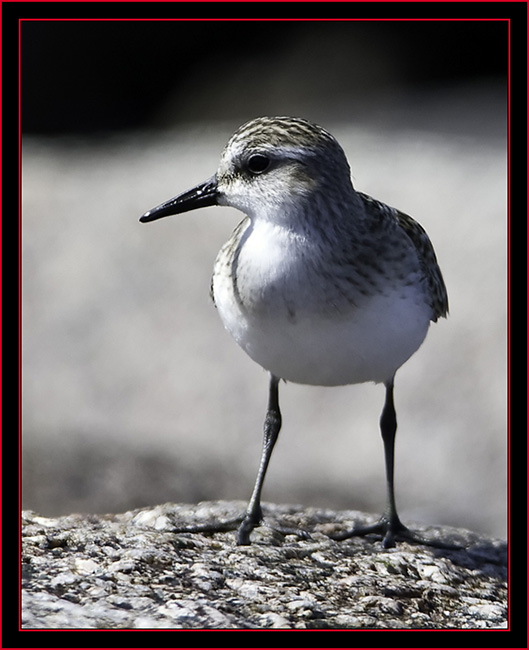
|
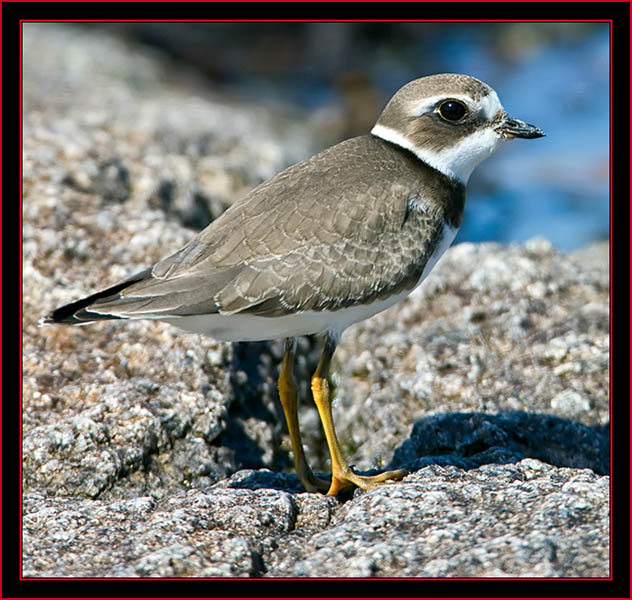
|
Besides the fact a human-sized figure or silhouette will spook everything wildlife related around it, another reason to stay low around the birds photographically is to view the scene at or near their level. The human eye is an exceptional tool, but as
bipeds we tend to see things from the same perspective often, much like the focal plane of a lens when tripod mounted – this creates a considerable angle to the subject below. Although being seated significantly reduces the range of motion where one
cannot swing the lens 360 degrees as when standing, it does reduce the camera/subject angle and can make for a compelling image.
Semipalmated Plover on Petit Manan IslandCanon EOS Mark III 1Ds, 1/640 second at 840mm; EF600mm f/4L + 1.4X at f/8, ISO 640 |
I was quite busy as the water crept closer to my tripod. The plan worked well and I was soon surrounded by shorebirds as I tracked them through the lens. The extended 600 millimeter lens requires a minimum of about twenty feet to achieve critical focus. Once
inside that distance it becomes a decoration more or less. I had two cameras and three lenses spread out around me. As the birds got closer I didn’t wish to move, which would clear all the subjects from the area, so I abandoned the 600mm lens and started
shooting with my 400mm f/5.6L lens, requiring just over eleven feet at minimum focus distance. Eventually the birds closed this distance and I switched over to the 70~200 f/2.8L lens with a focus distance of less than five feet. Yikes I thought to myself – how
cool is this for ‘up close and personal’?
Ruddy Turnstone on Petit Manan IslandCanon EOS Mark III 1Ds, 1/640 second at 840mm; EF600mm f/4L + 1.4X at f/8, ISO 640 |
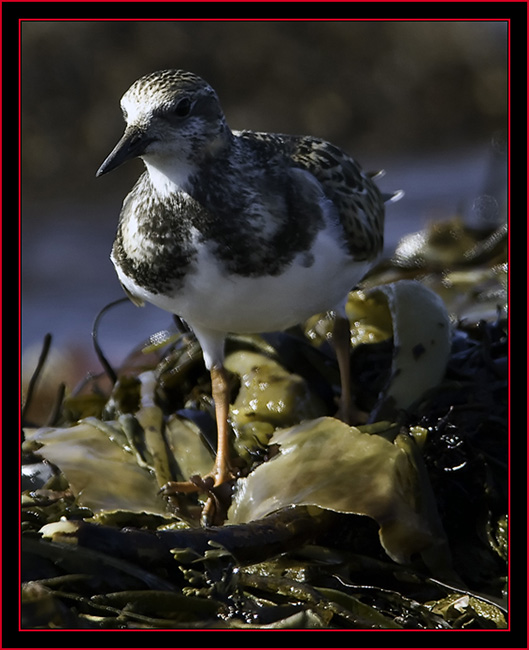
|
A Shorebird Sampler at 200, 400 & 840 Millimeter Focal Lengths...

|
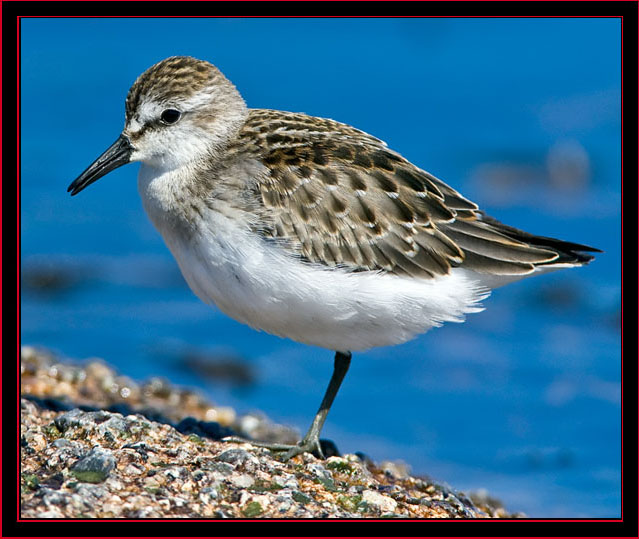
|
From around the boathouse and down on the rocks imaging shorebirds I had a good overview of the round-up preparations as the crew completed preparations in the capture zone. When the tide started to rise the Eider round-up
would commence in earnest... The preparation work resumed just after sunrise so the images in the next section occurred on the timeline anywhere from around 0630 hours until noon.
Least Sandpiper on Petit Manan IslandCanon EOS Mark III 1Ds, 1/2000 second at 840mm; EF600mm f/4L + 1.4X at f/8, ISO 640 |

|

|
The round-up crew had moved the boulders to clear a path in the capture zone yesterday. This morning they checked and made revisions as required while an opportunity to see the area exposed remained. As things progressed
I could see the advantage of this planning because once the area was flooded things sure looked a lot different from the scene above. With a sandy bottom walking the area was far less dangerous with your hands full. The yellow crates at
right would be used to get the eiders from the capture pen to the shore where the banding and sampling would take place. These were moved closer to the work area as part of the pre-round-up effort.
Crates for Moving Eiders...Canon EOS 5d, 1/640 second at 840mm; EF70~200mm f/2.8L at f/9, ISO 640 |

|


|
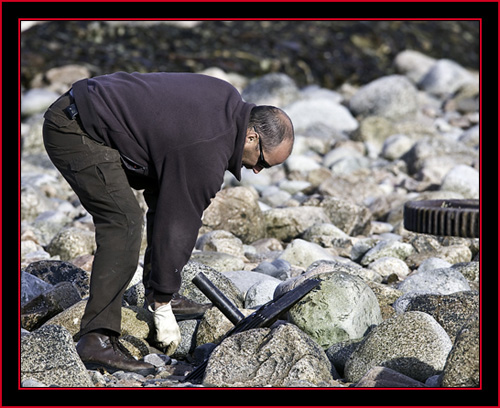
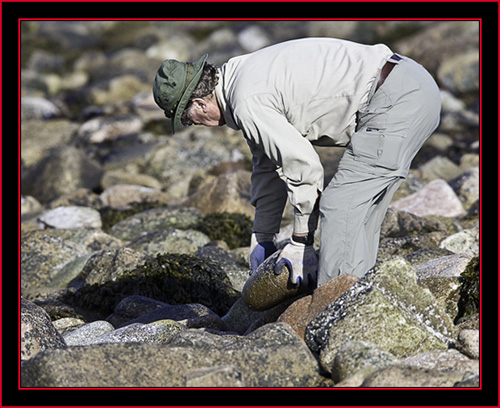
|


|
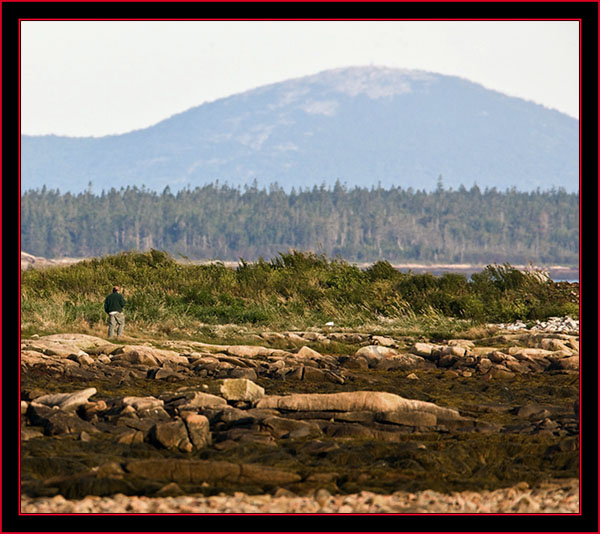
|
The next order of business was to construct the supports and fencing that would serve to contain the Eiders. As the ducks were herded by the crew on the water they would be bound by the fence. The flock would enter into the mouth of the capture
pen as the only avenue of movement remaining to them. This capture box was about ten feet long and in the upcoming images of the event it can be seen that the top is open to allow duck removals. The top is spanned by bungee cords to prevent the
eiders from getting out prior to being placed in the crates.
Long Distance View of Kelsey Seeking the Eider Flock from Green IslandCanon EOS Mark III 1Ds, 1/1000 second at 840mm; EF600mm f/4L + 1.4X at f/8, ISO 800 |
Constructing the Barrier...


|


|

|

|

|
